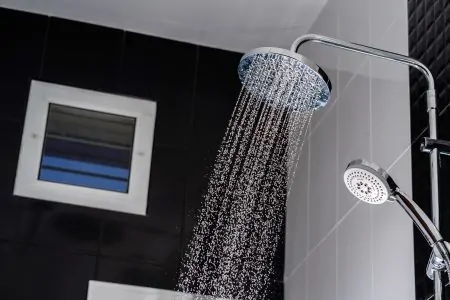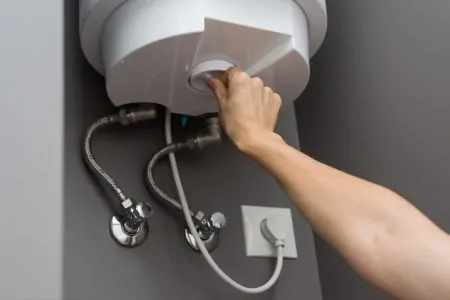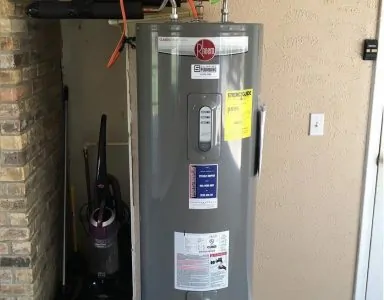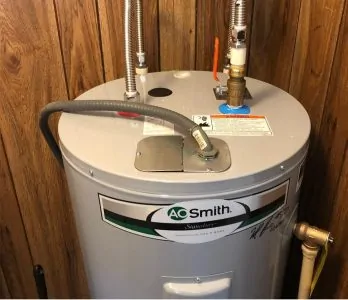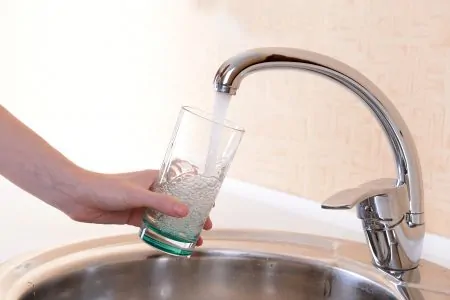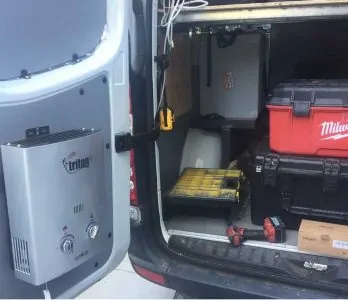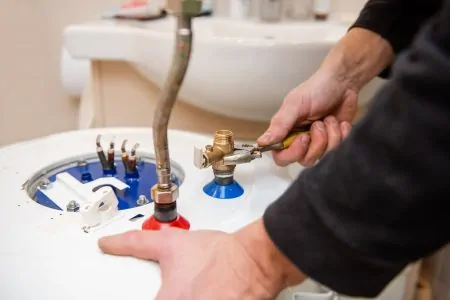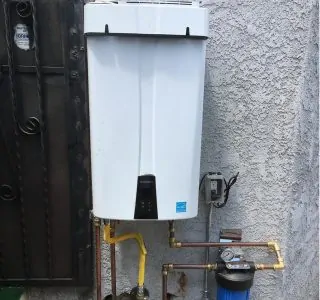Have you ever stepped into the shower only to be blasted by water that feels like it came straight from the Arctic Circle? Most of us have at some point and we know it’s a horrible way to start the day.
Finding the root of the problem isn’t always easy as there could be several reasons why your house currently lacks hot water. You might have to try a few different solutions to solve the issue.
In this article, we will explore the most common causes and tell you what to do when they occur. This will help you determine whether you can fix the issue personally or if it’s time to call a professional.
Key Takeaways
- Frozen pipes can cause hot water loss, so try to prevent freezing by insulating pipes and keeping the heat consistent.
- Water usage levels may affect hot water supply, so consider reducing shower time or upgrading to a larger water heater.
- Aging water heaters may lose efficiency; check the unit’s age and consider replacing if it’s over 10 years old.
- Poor maintenance can result in hot water loss; regularly check for leaks, flush the system, and follow the manufacturer’s maintenance guidelines.
Common Causes of Hot Water Loss
Even if we don’t always realize it, we use a lot of hot water today. It’s easy to take it for granted until it’s no longer available. If your water is not getting hot, it could be happening for one of several reasons.
1. Frozen Pipes
If you live in an area that experiences freezing weather, your pipes are at risk. Burst pipes due to freezing temperatures are a common occurrence during the winter (1).
There are ways to reduce the likelihood of burst pipes during very cold weather. Here are some simple preventative measures you can try if you’re concerned.
- Invest in pipe insulation: You can typically find pipe insulation for just 50 cents per foot.
- Keep your garage doors closed: If you have pipes running through an uninsulated garage, try to keep the doors closed as much as possible to shut out the cold.
- Open your cabinets: When cabinets are closed, the heat from your vents can’t reach the pipes. By leaving the doors open, you allow your main heat source to help keep the pipes working.
- Let your cold water drip: Letting your cold water drip will keep the water in the pipes moving. This seems like a waste of money but it should only add a few dollars to your bill. Those few dollars are nothing compared to what you would spend repairing a burst pipe.
- Leave the thermostat alone: Keep your thermostat at its usual temperature consistently. This also means leaving the heat on while you aren’t at home.
Prevention is ideal but what should you do if your pipes have already frozen? How can you even tell if a pipe is frozen? It might not be obvious, especially if it’s your wall pipes that end up freezing.
One of the most obvious hints that you have frozen pipes is if you turn on your faucet and little or no water trickles out. Be careful doing this; if you have a burst pipe, leaving the water on can cause flooding.
If you are confident that the pipe is only frozen and hasn’t burst, here’s what you can try.
- Turn your faucet on: Even cold water can help melt the ice.
- Apply heat to the frozen pipe section: You can use a heated pad, heater, or blow dryer to do this. Some people wrap towels soaked in hot water around the pipes.
- Apply the heat until full water flow is restored: This will ensure you have broken up the entirety of the ice blockage.
If you can’t locate the frozen pipe or thaw it completely, call a licensed plumber.
2. Water Usage Levels
Whether you have a traditional tank or tankless water heater and it is gas or electric, you should know your water usage levels.
There’s only so much you can do before your tank runs out of hot water. If it seems like you never have enough hot water or it runs out too quickly, it’s possible that your tank isn’t big enough for your water use.
In the case of an on-demand/tankless water heater, it might not be powerful enough. The smallest heaters will probably only work for a household of one. If you don’t live alone, someone will likely end up taking a cold shower.
The problem can also be caused by using too many appliances at once. If you run your dishwasher, washing machine, and shower at the same time, your water heater will need to work extra hard.
An average person uses between 8 and 100 gallons of water per day (2). Most of this usage comes from flushing the toilet, followed closely by taking showers or baths. If you think this is your issue, consider reducing your time spent in the shower.
3. Age of Unit
Another common issue is that your water heating unit is simply getting old. Like any appliance, as water heaters get older, they become less efficient. Most water heaters tend to last around 10 years, but how can you tell if it’s nearing its end?
Newer models have their age clearly printed on the equipment. If the age isn’t listed or visible, you will need the manufacturer’s name and the serial number of your unit. These should be clearly printed on the label on the equipment.
Manufacturers all use different date listing formats. They usually use the first four digits of the serial number or the first two letters, depending on the format. Check this if your water heater is not working well.
4. Poor Maintenance
Not having hot water could also be a sign of poor water heater maintenance. Whether you have a traditional tank or have gone tankless, heaters still need maintenance.
A poorly-maintained water heater can lead to needing to replace the entire unit. To avoid that, here are the best ways to maintain your water heater (3).
- Flush it: At least once per year.
- Inspect it: Check for leaks twice per year.
- Keep your faucets maintained: Take care of any leaks that occur. Dual handle faucets are recommended because they’re more efficient.
- Valve check: Raise and lower the TP valve lever once each year.
- Air intake: If you have a gas water heater, clean the air intake regularly.
- Deterioration: Look for any damaged or broken pieces.
- Water pressure: Test your water pressure regularly.
- Read the manual: The manual should provide any additional maintenance suggestions from the company.
5. Unit is too Small
There is a chance that your water heater simply isn’t big enough to supply your home. In this case, you will need to replace it or buy additional heaters to keep up with your usage.
If you need more hot water, you have plenty of options. Whether you choose to go tankless, solar-powered, or traditional tank, there are different ways to resize each system (4).
Sizing a Tankless Water Heater
When estimating the size needed for tankless water heaters, you first need to decide what they will be used for. Do you want a heater to power the entire house or just one room? If you aren’t sure how to answer that, ask yourself this:
- How many appliances will be using hot water at the same time? Once you determine this, figure out their flow rate in gallons per minute. The total flow rate will tell you what size water heater you need.
Sizing a Solar Water Heater
An appropriately sized solar water heater should fulfill 90-100 percent of your household needs during the summer. To find that size, you will need to determine a few things:
- Collector area: A general rule for this is to account for 20 square feet for the first two family members. For each additional person, simply add an extra eight square feet if you live in the U.S. Sunbelt Area. Add 12-14 if you live in the Northern U.S.
- Storage volume: 50-60 gallon tanks are usually enough for between one and three people. 80 gallons is best for 3-4 people and an even larger tank for bigger families.
- Additional calculations: You will also need to evaluate the area’s solar resource and determine the proper orientation and tilt of the solar collector.
Sizing a Traditional Tank
If you go with a traditional tank, you will need to know its first-hour rating. The first-hour rating is the number of gallons of hot water it can supply per hour. You need to buy a size that matches or is within one or two gallons of your peak hot water usage.
To determine your peak water usage, figure out what time of day you use the most hot water in your home. The number of people living with you will also factor into this. Compare it to the following chart.
| Activity | Ave. usage (gallons) | Times used/1 hour | = Gallons/hour |
| Showers and baths | 10 | ||
| Hand washing and food prep | 4 | ||
| Dishwasher | 6 | ||
| Clothes washer | 7 |
Once you have filled it out, add up the total number of gallons used per hour and you will have an answer.
6. Damaged Parts
The most obvious reason for a lack of hot water is damaged parts or burnt out heating elements. When parts don’t work, the heater won’t be able to do its job correctly.
A unit’s dip tube is one of the most common pieces to get worn out. This is because it spends much of its time submerged in water. The dip tube is what directs cold water down to the bottom of the system.
Damaged thermostats can also contribute to hot water loss. When the thermostat doesn’t work properly, it can confuse hot water with cold, thus supplying cold water instead.
Pay special attention to a smell like rotten eggs. If you smell this, it could be the magnesium rod that is damaged (5).
When to Call a Professional
A professional isn’t always needed when you experience a lack of hot water. We suggest first trying to limit your hot water use to see if you’re using too much for your heater.
If that helps but you aren’t ready to give up your long showers, consider contacting a professional. They will be able to install a second, or a more powerful, water heater to meet your demands.
If you see damaged or broken parts or find a leak, consult an expert. A leaky water heater can cause mold in your home which can be very dangerous (6).
If your water heater makes loud noises or you smell gas, you should call a professional plumber to investigate. These signs can indicate bigger issues than an amateur should try to tackle.
